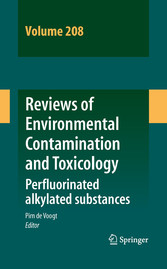Suchen und Finden
Mehr zum Inhalt

Reviews of Environmental Contamination and Toxicology Volume 208 - Perfluorinated alkylated substances
Special Foreword
4
Foreword
7
Preface
9
Contents
11
Contributors
12
Atmospheric Perfluorinated Acid Precursors: Chemistry, Occurrence, and Impacts
13
1 Introduction
14
2 Mechanisms of Atmospheric Formation of Perfluorinated Acids
16
2.1 Perfluorocarboxylic Acids
16
2.1.1 Mechanisms for Atmospheric Formation of Perfluoroacyl Halides
16
2.1.2 Mechanisms for Direct Atmospheric Formation of PFCAs
20
2.2 Perfluorosulfonic Acids (PFSAs)
23
3 Chemistry of Perfluorinated Acid (PFA) Precursors
24
3.1 Volatile Anesthetics
25
3.1.1 CF3 (CF2) x CHClBr
25
3.1.2 CF3 (CF2) x CHClOCHF2
27
3.2 Hydrochlorofluorocarbons (HCFCs)
28
3.2.1 CF3 (CF2) x CHFCl
28
3.2.2 CF3 (CF2) x CHCl2
32
3.3 Hydrofluorocarbons (HFCs, Non-telomer Based)
34
3.3.1 Saturated Hydrofluorocarbons (HFCs)
34
3.3.2 Hydrofluoroolefins (HFOs)
41
3.4 Fluorotelomer and Related Compounds
47
3.4.1 Perfluorinated Aldehyde (PFAL) Hydrates
47
3.4.2 Perfluorinated Aldehydes (PFALs)
53
3.4.3 Fluorotelomer Aldehydes (FTALs)
57
3.4.4 Odd Fluorotelomer Alcohols (oFTOHs)
59
3.4.5 Even Fluorotelomer Alcohols (FTOHs)
60
3.4.6 Fluorotelomer Olefins (FTOs)
63
3.4.7 Fluorotelomer Iodides (FTIs)
65
3.4.8 Fluorotelomer Acrylate (FTAc)
66
3.5 Perfluoroalkanesulfonamides
68
3.5.1 N -Alkyl-perfluoroalkanesulfonamides (NAFSA)
68
3.5.2 N -Alkyl-perfluoroalkanesulfamidoethanols (NAFSE)
71
4 Atmospheric Sources and Levels
73
4.1 Volatile Fluorinated Anesthetics
73
4.2 Hydrochlorofluorocarbons (HCFCs)
73
4.2.1 Potential Sources to the Atmosphere
73
4.2.2 Atmospheric Concentrations
73
4.3 Hydrofluorocarbons (HFCs, Non-telomer Based)
74
4.3.1 Saturated Hydrofluorocarbons (HFCs)
74
4.3.2 Hydrofluoroolefins (HFOs)
78
4.4 Fluorotelomer Compounds
78
4.4.1 Potential Sources to the Atmosphere
78
4.4.2 Atmospheric Concentrations
79
4.5 Perfluorosulfonamides
89
4.5.1 Potential Sources to the Atmosphere
89
4.5.2 Atmospheric Concentrations
94
5 Impact of Precursors on Environmental Perfluorinated Acid (PFA) Levels
94
5.1 Trifluoroacetic Acid (TFA)
94
5.2 Perfluorooctanesulfonic Acid (PFOS), Perfluorooctanoic Acid (PFOA) and Perfluorononanoic Acid (PFNA)
106
5.3 Long-Chained Perfluorocarboxylic Acids (PFCAs)
109
6 Summary
110
References
110
Isomer Profiling of Perfluorinated Substances as a Tool for Source Tracking: A Review of Early Findings and Future Applications
122
1 Introduction
122
2 Isomer Nomenclature
123
3 Historical and Current Manufacturing Sources of Perfluoroalkyl Isomers
126
4 Isomer-Specific Analytical Methodologies
134
4.1 Current Analytical Separation Methods
134
4.2 Analytical Quantification Bias
137
4.3 Strategies for Isomer Separation by LC--MS/MS
141
5 Influence of PhysicalChemical Properties on Environmental Fractionation of Perfluoroalkyl Isomers
142
6 Characterization of Perfluoroalkyl Isomer Profiles in the Environment
148
6.1 PFOA Isomer Profiles
148
6.2 Perfluoroalkyl Sulfonate and Sulfonamide Isomer Profiles
150
6.3 Perfluorocarboxylate Isomer Profiles Other than PFOA
159
7 Differences in Toxicity and Bioaccumulation of PFA Isomers
160
8 Summary
164
References
165
Biodegradation of Fluorinated Alkyl Substances
172
1 Introduction
172
2 The Persistence of Perfluorinated Surfactants
173
3 Understanding the Complex Biodegradation of Fluorotelomer-based Chemicals
176
4 Biodegradation of N-Alkyl Perfluorooctane Sulfonamide Derivatives
179
5 The Role of Fluorinated Polymers
181
6 On the Way to Mineralization Biodegradation of Organic Molecules that Have Low Fluorine Content
182
7 Summary
185
References
186
Perfluorinated Substances in Human Food and Other Sources of Human Exposure
189
1 Introduction
189
2 PFCs in Edible Fish and Seafood
190
3 Contamination of Food
205
3.1 Indirect Contamination of PFCs in Food Items
205
3.2 Direct Contamination of PFCs in Commercial Food Items
206
4 PFCs in Drinking Water
209
5 Safety Limits and Tolerable Daily Intakes
212
6 Perfluorinated Compounds in House Dust and Air
214
7 Correlation Between PFCs
217
8 Outlook
219
9 Summary
219
References
221
Index
226
Alle Preise verstehen sich inklusive der gesetzlichen MwSt.















